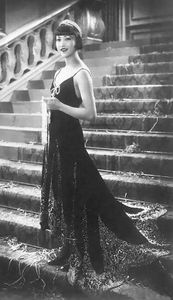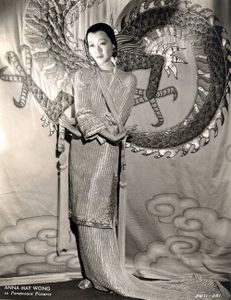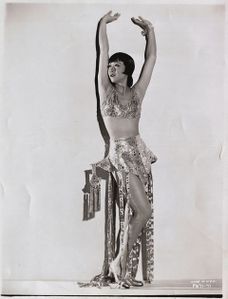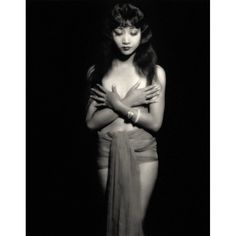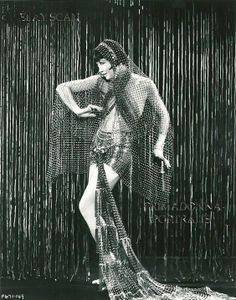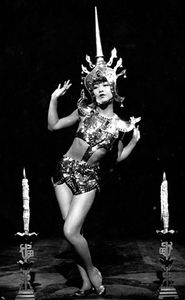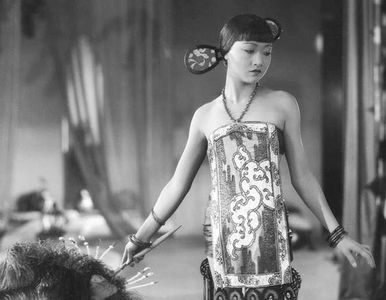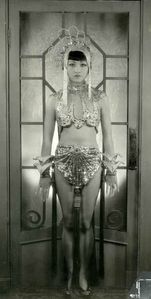Anna May Wong
| Anna May Won | ||
 Publicity photo of Anna May Wong from Stars of the Photoplay, 1930 | ||
| Background information | ||
| Born as: | Wong Liu Tsong | |
| Born | Jan 3, 1905 Los Angeles, California, U.S. | |
| Died | Feb 3, 1961 - at age 55 Santa Monica, California, U.S. Heart attack | |
| Occupation: | Actress | |
| Awards: | Hollywood Walk of Fame – Motion Picture 1700 Vine Street, Hollywood, California (map) | |
Anna May Wong (born Wong Liu Tsong ✦January 3, 1905 – †February 3, 1961), was an American actress, considered the first Chinese American film star in Hollywood, as well as the first Chinese American actress to gain international recognition. Her varied career spanned silent film, sound film, television, stage, and radio.
Born in Los Angeles to first-generation Taishanese Chinese American parents, Wong became engrossed with films and decided at the age of 11 that she would become an actress. Her first role was as an extra in the movie The Red Lantern (1919). During the silent film era, she acted in The Toll of the Sea (1922), one of the first films made in color, and in Douglas Fairbanks' The Thief of Bagdad (1924). Wong became a fashion icon and achieved international stardom in 1924. Wong had been one of the first to embrace the flapper look. In 1934, the "Mayfair Mannequin Society of New York" voted her the "world's best dressed woman." In the 1920s and 1930s, Wong was acclaimed as one of the top fashion icons.
Frustrated by the stereotypical supporting roles she reluctantly played in Hollywood, Wong left for Europe in March 1928, where she starred in several notable plays and films, among them Piccadilly (1929). She spent the first half of the 1930s traveling between the United States and Europe for film and stage work. Wong was featured in films of the early sound era, and went on to appear in Daughter of the Dragon (1931), with Marlene Dietrich in Josef von Sternberg's Shanghai Express (1932), Java Head (1934), and Daughter of Shanghai (1937).[4]
In 1935, Wong was dealt the most severe disappointment of her career, when Metro-Goldwyn-Mayer refused to consider her for the leading role of the Chinese character O-Lan in the film version of Pearl S. Buck's The Good Earth. MGM instead cast Luise Rainer to play the leading role in yellowface. One biographer believes that the choice was due to the Hays Code anti-miscegenation rules requiring the wife of a white actor, Paul Muni (ironically playing a Chinese character in yellowface) to be played by a white actress. But the 1930–1934 Hays Code of the Motion Picture Producers and Distributors of America insisted only that "miscegenation (sex relationship between the white and black races) was forbidden" and said nothing about other interracial marriages. Other biographers have not corroborated this theory, including historian Shirley Jennifer Lim's Anna May Wong: Performing the Modern. MGM screen-tested Wong for the supporting role of Lotus, the seductress, but it is ambiguous whether she refused the role on principle or was rejected.
Wong spent the next year touring China, visiting her family's ancestral village, studying Chinese culture, and documenting the experience on film at a time when prominent female directors in Hollywood were few.
In the late 1930s, she starred in several B movies for Paramount Pictures, portraying Chinese and Chinese Americans in a positive light.
She paid less attention to her film career during World War II, when she devoted her time and money to help the Chinese cause against Japan. Wong returned to the public eye in the 1950s in several television appearances.
In 1951, Wong made history with her television show The Gallery of Madame Liu-Tsong, the first-ever U.S. television show starring an Asian-American series lead. She had been planning to return to film in Flower Drum Song when she died in 1961, at the age of 56, from a heart attack. For decades after her death, Wong was remembered principally for the stereotypical "Dragon Lady" and demure "Butterfly" roles that she was often given. Her life and career were re-evaluated in the years around the centennial of her birth, in three major literary works and film retrospectives.
- Anna Mae Wong
- More information is available at [ Wikipedia:Anna_May_Wong ]
See Also
Source
External links
- Anna May Wong at the Internet Movie Database
- Anna May Wong at the Internet Broadway Database
- Anna May Wong Abroad | A digital collection of materials from the Harvard Theatre Collection.
- Hong, Yunah (2011). Anna May Wong: In Her Own Words.
- Anna May Wong Tobacco Cards, http://film.virtual-history.com/person.php?personid=638
Chat rooms • What links here • Copyright info • Contact information • Category:Root
